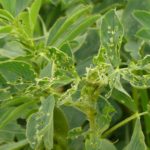
This article was originally written by Joel Bagg in 2013. It was edited May 25th, 2022 by Christine O'Reilly to reflect current insecticide options to control alfalfa weevil. Alfalfa weevil can be an issue in Ontario, particularly in south-western parts of the province. While outbreaks tend to be isolated, they can be severe and dramatically [...]
